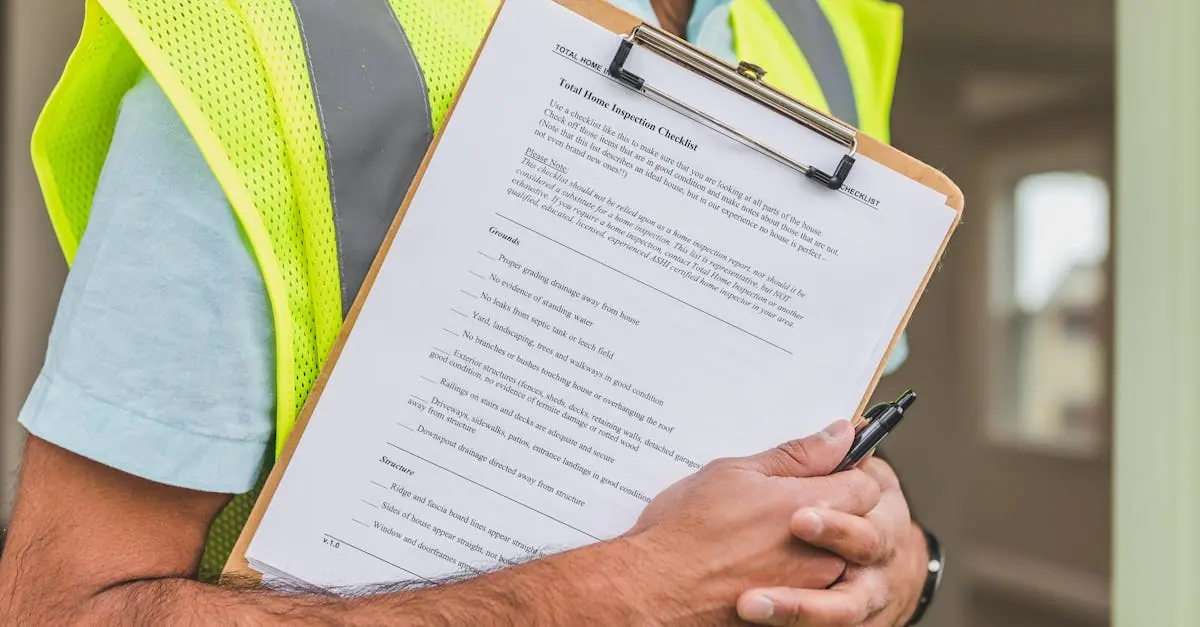Metro systems are the lifeblood of urban commuting, whisking people from point A to point B faster than you can say “where’s my train?” But behind the scenes, there’s a whole team of unsung heroes making sure those trains run smoothly. Enter the metro maintenance checklist, the trusty sidekick every transit authority needs. Without it, chaos could reign, and nobody wants to be stuck on a train with a malfunctioning air conditioner—yikes!
Imagine a world where trains glide seamlessly, tracks shimmer with cleanliness, and every station feels like a five-star hotel. With a solid maintenance checklist in hand, that dream can become reality. It’s not just about fixing things when they break; it’s about preventing disasters before they happen. So buckle up as we dive into the essentials of metro maintenance that keep the wheels turning and the commuters smiling.
Table of Contents
ToggleImportance Of A Metro Maintenance Checklist
A metro maintenance checklist ensures safety and reliability in urban systems. Regular inspections help identify potential issues before they escalate. Efficient operation results from addressing mechanical failures, keeping everything running smoothly. The checklist covers various aspects, including trains, tracks, and stations, critical for maintaining service quality.
Preventive maintenance reduces the chances of outages, which can disrupt commuters’ experiences. Scheduled checks protect investments in infrastructure, optimizing overall performance. Tracking maintenance records offers insights that inform decision-making and resource allocation.
The maintenance checklist includes items such as inspecting electrical systems, ensuring cleanliness, and assessing signaling equipment. Regular train servicing, including brake and engine checks, plays a vital role in passenger safety. Station evaluations evaluate escalators and elevators, enhancing accessibility for all users.
Effective communication among maintenance teams enhances collaboration. Teams rely on clearly defined responsibilities outlined in the checklist. Verification processes confirm that each task is completed before operations resume.
Incorporating technology aids in managing the checklist. Digital tools streamline reporting and allow for real-time updates. This digital integration facilitates faster response times and enhances overall operational efficiency.
Implementing a structured maintenance checklist fosters a proactive culture within metro systems. Regular adherence to this checklist leads to improved commuter satisfaction and trust in public transit. Presence of a comprehensive checklist signifies a commitment to operational excellence and long-term planning.
Key Components Of A Metro Maintenance Checklist
A comprehensive metro maintenance checklist focuses on various inspection intervals, ensuring all components operate safely and efficiently. Structured inspections contribute to the overall reliability of metro systems.
Daily Inspections
Daily inspections serve as the first line of defense in maintenance. Crews examine trains for mechanical issues, prioritizing braking systems, lights, and safety features. They also inspect tracks for any visible damage, checking for debris or obstructions that could disrupt service. Cleanliness is evaluated as well, ensuring stations and trains meet cleanliness standards. Prompt identification of minor issues during daily checks prevents escalation into significant problems.
Weekly Inspections
Weekly inspections involve a more detailed assessment of systems. Maintenance teams inspect electrical and signaling systems, ensuring functionality and proper calibration. Teams also assess train cars for wear and tear, including doors and windows, replacing components when necessary. Tracks undergo a thorough examination, with special attention to alignment and any signs of deterioration. This routine check enhances the operational reliability of the metro, making it essential for continued service.
Monthly Inspections
Monthly inspections provide an opportunity for in-depth evaluations. Maintenance personnel conduct comprehensive reviews of all mechanical systems, including engines and suspension components. They review maintenance records, identifying trends that may indicate recurring issues. Additionally, safety equipment receives focused attention to ensure compliance with regulations. Regular monthly checks contribute significantly to long-term operational efficiency, safeguarding infrastructure investments and enhancing passenger safety.
Benefits Of Regular Metro Maintenance
Regular metro maintenance enhances the overall effectiveness and safe operation of transportation systems. Prioritizing maintenance leads to significant benefits for commuters and infrastructure alike.
Improved Safety
Enhanced safety measures emerge from consistent metro maintenance practices. Routine inspections identify potential hazards, preventing accidents and ensuring a secure travel environment. Trains undergo extensive checks for mechanical issues, reducing the likelihood of operational failures. Tracks receive evaluations to spot wear and tear, which could lead to derailments. Functional signaling systems contribute to synchronized operations, mitigating human error during peak hours. Each task on a maintenance checklist contributes to a safer commuting experience, significantly lowering the risks associated with public transit.
Increased Efficiency
Regular maintenance boosts operational efficiency throughout metro systems. Daily inspections catch mechanical discrepancies early, minimizing delays caused by unexpected breakdowns. Weekly assessments of electrical systems improve signaling and communication, allowing trains to run on schedule. Monthly in-depth evaluations ensure all components perform optimally, streamlining service delivery. Efficient routes result from meticulously maintained tracks, enhancing travel times for passengers. Every maintenance task directly correlates with improved reliability, leading to passenger satisfaction and fostering trust in public transport. The benefits of proper metro upkeep resonate throughout the entire urban commuting landscape.
Challenges In Implementing A Metro Maintenance Checklist
Implementing a metro maintenance checklist presents several challenges that can impede efficiency. Staffing limitations often hinder the ability to perform regular inspections, which impacts compliance with safety standards. If personnel lack proper training in using the checklist, errors could occur during inspections, leading to missed issues.
Time constraints pose another significant challenge. Tight operational schedules may reduce the time available for thorough inspections, forcing teams to rush tasks. Inadequate resources, such as aging tools or insufficient technology, can further complicate adherence to maintenance protocols.
Communication gaps within the maintenance team affect execution of the checklist. If responsibilities aren’t clearly defined, accountability may diminish, reducing the overall effectiveness of maintenance efforts. Environmental factors, including extreme weather conditions or construction activities, may disrupt scheduled maintenance activities, leading to delays.
Technological integration introduces challenges as well. Resistance to adopting new systems can occur among team members, limiting the intended benefits of enhanced reporting and tracking capabilities. Data management issues can arise when inputting inspection results into maintenance systems, complicating record-keeping and analysis.
Coordination with other departments is crucial for a successful implementation. Lack of collaboration between operational and maintenance teams can cause conflicts, resulting in oversight of essential tasks. Ultimately, addressing these challenges requires strategic planning, proper resource allocation, and fostering a culture of communication within the metro systems.
Conclusion
A well-structured metro maintenance checklist is vital for ensuring the safety and efficiency of urban transit systems. By prioritizing regular inspections and preventive maintenance, metro operators can significantly reduce disruptions and enhance the overall commuter experience.
Effective communication among maintenance teams and the integration of technology streamline processes and improve operational performance. Addressing the challenges of staffing and resource allocation is essential for maintaining high standards.
Ultimately, a commitment to thorough maintenance practices not only fosters a culture of excellence but also builds trust and satisfaction among passengers. Investing in metro upkeep is an investment in the future of urban transportation.








